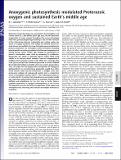| dc.contributor.author | Johnston, David T | |
| dc.contributor.author | Wolfe-Simon, Felisa Lauren | |
| dc.contributor.author | Pearson, Ann | |
| dc.contributor.author | Knoll, Andrew Herbert | |
| dc.date.accessioned | 2010-04-13T14:34:18Z | |
| dc.date.issued | 2009 | |
| dc.identifier.citation | Johnston, David T, Felicia L. Wolfe-Simon, Ann Pearson, and Andrew Herbert Knoll. 2009. Anoxygenic Photosynthesis Modulated Proterozoic Oxygen and Sustained Earth’s Middle Age. PNAS 106(40): 16925-16929. | en_US |
| dc.identifier.issn | 0027-8424 | en_US |
| dc.identifier.uri | http://nrs.harvard.edu/urn-3:HUL.InstRepos:3934550 | |
| dc.description.abstract | Molecular oxygen (O2) began to accumulate in the atmosphere and surface ocean ca. 2,400 million years ago (Ma), but the persistent oxygenation of water masses throughout the oceans developed much later, perhaps beginning as recently as 580–550 Ma. For much of the intervening interval, moderately oxic surface waters lay above an oxygen minimum zone (OMZ) that tended toward euxinia (anoxic and sulfidic). Here we illustrate how contributions to primary production by anoxygenic photoautotrophs (including physiologically versatile cyanobacteria) influenced biogeochemical cycling during Earth's middle age, helping to perpetuate our planet's intermediate redox state by tempering O2 production. Specifically, the ability to generate organic matter (OM) using sulfide as an electron donor enabled a positive biogeochemical feedback that sustained euxinia in the OMZ. On a geologic time scale, pyrite precipitation and burial governed a second feedback that moderated sulfide availability and water column oxygenation. Thus, we argue that the proportional contribution of anoxygenic photosynthesis to overall primary production would have influenced oceanic redox and the Proterozoic O2 budget. Later Neoproterozoic collapse of widespread euxinia and a concomitant return to ferruginous (anoxic and Fe2+ rich) subsurface waters set in motion Earth's transition from its prokaryote-dominated middle age, removing a physiological barrier to eukaryotic diversification (sulfide) and establishing, for the first time in Earth's history, complete dominance of oxygenic photosynthesis in the oceans. This paved the way for the further oxygenation of the oceans and atmosphere and, ultimately, the evolution of complex multicellular organisms. | en_US |
| dc.description.sponsorship | Organismic and Evolutionary Biology | en_US |
| dc.language.iso | en_US | en_US |
| dc.publisher | National Academy of Sciences | en_US |
| dc.relation.isversionof | doi:10.1073/pnas.0909248106 | en_US |
| dc.relation.hasversion | http://www.vietwebdisk.com/www.pnas.org/content/106/40/16925.full | en_US |
| dash.license | LAA | |
| dc.subject | ocean chemistry | en_US |
| dc.subject | primary production | en_US |
| dc.subject | Proterozoic biosphere | en_US |
| dc.title | Anoxygenic Photosynthesis Modulated Proterozoic
Oxygen and Sustained Earth’s Middle Age | en_US |
| dc.type | Journal Article | en_US |
| dc.description.version | Version of Record | en_US |
| dc.relation.journal | Proceedings of the National Academy of Sciences of the United States of America | en_US |
| dash.depositing.author | Knoll, Andrew Herbert | |
| dc.date.available | 2010-04-13T14:34:18Z | |
| dc.identifier.doi | 10.1073/pnas.0909248106 | * |
| dash.contributor.affiliated | Wolfe-Simon, Felisa Lauren | |
| dash.contributor.affiliated | Knoll, Andrew | |
| dash.contributor.affiliated | Johnston, David | |
| dash.contributor.affiliated | Pearson, Ann | |


